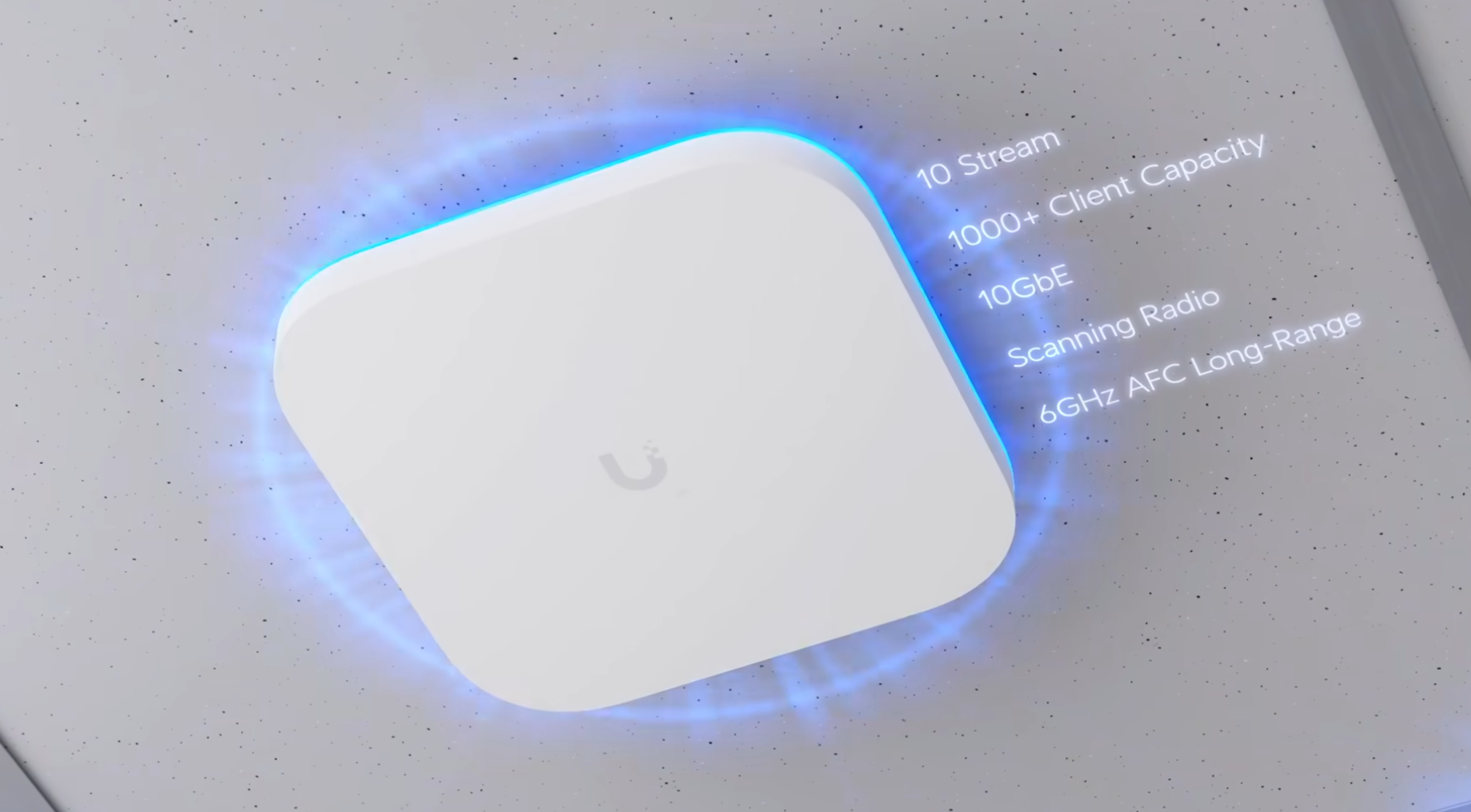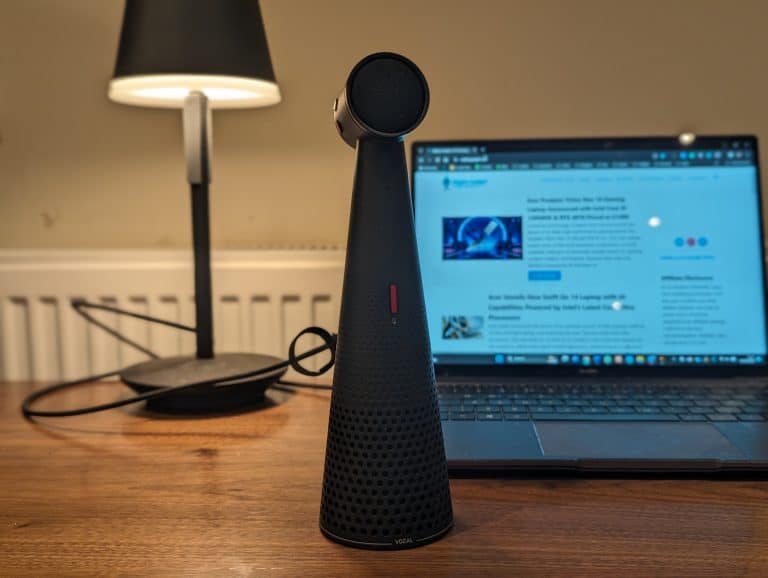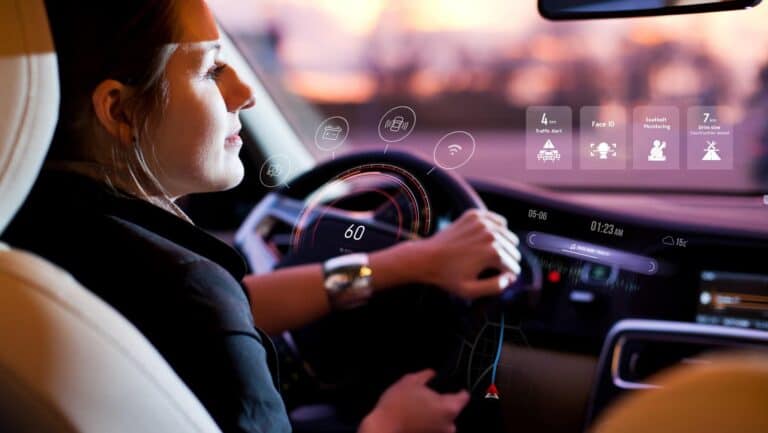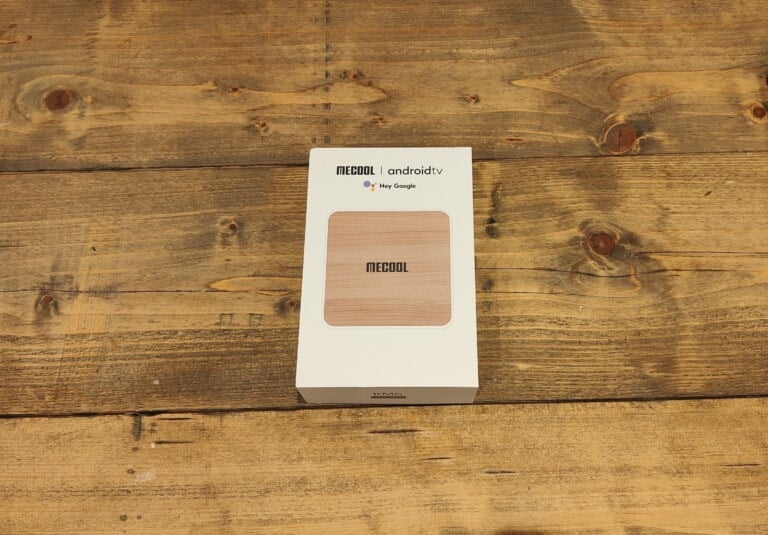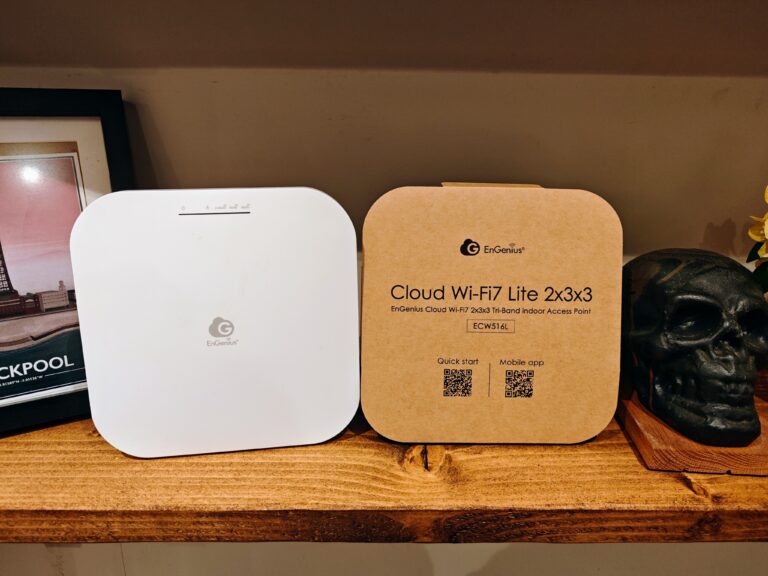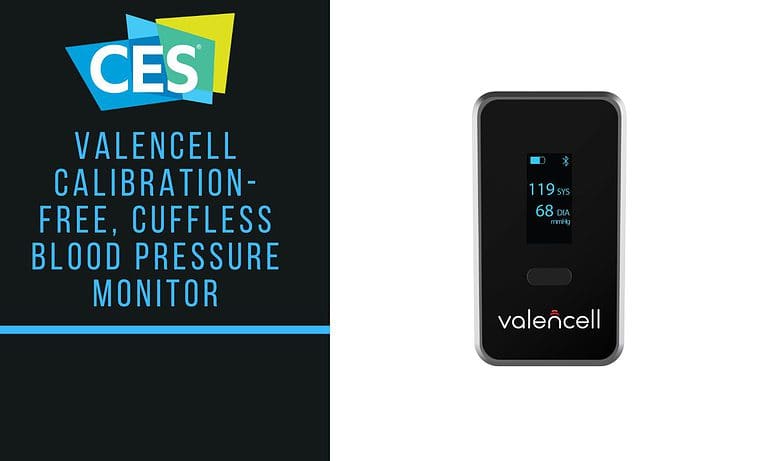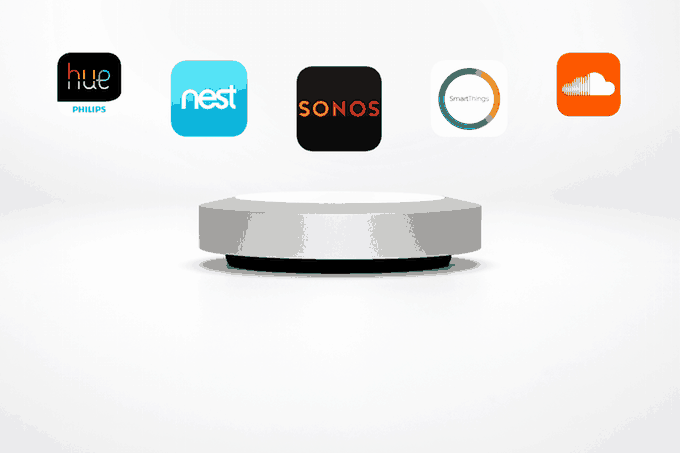Any links to online stores should be assumed to be affiliates. The company or PR agency provides all or most review samples. They have no control over my content, and I provide my honest opinion.
Ubiquiti has recently expanded its Wi-Fi 7 lineup with several new access points (APs), catering to various needs and environments. This article will delve into the specifications and features of the U7 Pro, U7 Pro Max, U7 Pro Wall, U7 Outdoor, and E7, with a particular focus on the performance differences between the U7 Pro, U7 Pro Max, and Unifi E7 models.
Related Content
- Ubiquiti’s UniFi Enterprise Wi-Fi 7 Lineup: Unifi E7, E7 Audience, and E7 Campus
- Ubiquiti Unifi Switch Flex Mini 2.5G Review
- Ubiquiti Unifi Pro Max 16 Review
- UniFi 7 Pro Max vs UniFi 7 Pro vs U7 Pro Wall vs U7 Outdoor WiFi 7 Access Points
Overview of the Wi-Fi 7 Lineup

Ubiquiti’s Wi-Fi 7 range includes:
- U7 Pro: An entry-level Wi-Fi 7 AP
- U7 Pro Max: A higher-performance variant of the U7 Pro
- U7 Pro Wall: A wall-mountable Wi-Fi 7 AP
- U7 Outdoor: A weatherproof Wi-Fi 7 AP for outdoor use
- E7: An enterprise-grade Wi-Fi 7 AP
Each model is designed to cater to specific deployment scenarios and performance requirements. Let’s examine the key differences and benefits of each model.
Ubiquiti Unifi E7 vs U7 Pro Max vs U7 Pro WiFi 7 Access Point Specification Comparison
| Specification | U7 Pro | U7 Pro Max | U7 Pro Wall | U7 Outdoor | E7 |
|---|---|---|---|---|---|
| Model SKU | BE10800 Flagship | BE15200 Flagship | BE10800 Wall | BE5000 Outdoor | BE21000 Enterprise |
| MSRP (US) | $189 | $279 | $199 | $199 | $499 |
| Release Date | Available | Available | Available | Available | Available |
| Wi-Fi Standard | Wi-Fi 7 | Wi-Fi 7 | Wi-Fi 7 | Wi-Fi 7 | Wi-Fi 7 |
| 2.4 GHz MIMO | 2×2 | 2×2 | 2×2 | 2×2 | 2×2 |
| 2.4 GHz Width | 40 MHz | 40 MHz | 40 MHz | 40 MHz | 40 MHz |
| 2.4 GHz Rate | 688 Mbps | 688 Mbps | 688 Mbps | 688 Mbps | 688 Mbps |
| 5 GHz MIMO | 2×2 | 4×4 | 2×2 | 2×2 | 4×4 |
| 5 GHz Width | 240 MHz (2×2) | 240 MHz (4×4) | 240 MHz (2×2) | 240 MHz (2×2) | 240 MHz (4×4) |
| 5 GHz Rate | 4324 Mbps | 8648 Mbps | 4324 Mbps | 4324 Mbps | 8648 Mbps |
| 6 GHz MIMO | 2×2 | 2×2 | 2×2 | – | 4×4 |
| 6 GHz Width | 320 MHz | 320 MHz | 320 MHz | – | 320 MHz |
| 6 GHz Rate | 5765 Mbps | 5765 Mbps | 5765 Mbps | – | 11529 Mbps |
| Max TX Power | 22/26/23 dBm | 23/29/23 dBm | 22/26/23 dBm | 23/26/- dBm | 23/30/24 dBm |
| Antenna Gain | 4/6/5.8 dBi | 4/6/5.9 dBi | 4/5/6 dBi | 90°/45°/- | 5/6/6 dBi |
| Coverage | 140 m²/1,500 ft² | 160 m²/1,750 ft² | 140 m²/1,500 ft² | 465 m²/5,000 ft² | 185 m²/2,000 ft² |
| Max Clients | 300+ | 500+ | 300+ | 200+ | 1000+ |
| Ethernet Ports | (1) 2.5 Gbps | (1) 2.5 Gbps | (1) 2.5 Gbps | (1) 2.5 Gbps | (1) 10 Gbps, (1) 1 Gbps |
| PoE Standard | PoE+ / 48V | PoE+ / 48V | PoE+ / 48V | PoE+ / 48V | PoE++ / 48V |
| Power Usage | 21W | 25W | 22W | 19W | 43W |
| Dimensions | Ø206 x 46 mm | Ø206 x 46 mm | 150 x 103 x 36 mm | 170 x 208 x 54.5 mm | 250 x 250 x 44 mm |
| Weight | 680g | 680g | Not specified | Not specified | Not specified |
| Environment | Indoor | Indoor | Indoor | Indoor/Outdoor (IP67) | Indoor |
| Special Features | MLO support coming | Spectral analysis | Wall mount design | External antennas | Enterprise-grade |
U7 Pro vs U7 Pro Max vs E7: Performance Comparison
Wi-Fi Capabilities
All three models support Wi-Fi 7 and are tri-band, operating on 2.4 GHz, 5 GHz, and 6 GHz frequencies. However, there are significant differences in their MIMO configurations and throughput capabilities:
U7 Pro:
- 2.4 GHz: 2×2 MIMO, 688 Mbps
- 5 GHz: 2×2 MIMO, 4324 Mbps
- 6 GHz: 2×2 MIMO, 5765 Mbps
U7 Pro Max:
- 2.4 GHz: 2×2 MIMO, 688 Mbps
- 5 GHz: 4×4 MIMO, 8648 Mbps
- 6 GHz: 2×2 MIMO, 5765 Mbps
E7:
- 2.4 GHz: 2×2 MIMO, 688 Mbps
- 5 GHz: 4×4 MIMO, 8648 Mbps
- 6 GHz: 4×4 MIMO, 11529 Mbps
The U7 Pro Max and E7 offer superior performance on the 5 GHz band compared to the U7 Pro, thanks to their 4×4 MIMO configuration. The E7 takes this a step further by also providing 4×4 MIMO on the 6 GHz band, resulting in nearly double the throughput of the other models on this frequency.
4×4 vs 2×2 MIMO
Benefits of 4×4 vs 2×2 MIMO
The importance of 4×4 MIMO in Wi-Fi access points (APs) when most client devices only support 2×2 MIMO is a nuanced topic. While 4×4 MIMO does offer some benefits, its advantages may be limited in certain scenarios.
Increased Capacity
4×4 MIMO APs can theoretically handle more simultaneous connections than their 2×2 counterparts. A 4×4 AP can communicate with up to four 1×1 clients or two 2×2 clients simultaneously, potentially improving overall network capacity. This can be particularly beneficial in high-density environments where multiple devices are competing for airtime.
Improved Signal Quality
Even when communicating with 2×2 or 1×1 clients, a 4×4 MIMO AP can provide better signal quality due to spatial diversity. The additional antennas allow for more robust signal reception and transmission, potentially leading to improved range or higher data rates at greater distances.
Limitations and Considerations
Client Device Limitations
Most consumer devices, including smartphones, tablets, and laptops, typically support only 1×1 or 2×2 MIMO. This means that the full potential of a 4×4 AP may not be realised in many home or small office environments.
Diminishing Returns
The performance gain from 2×2 to 4×4 MIMO is not linear. While the jump from SISO to 2×2 MIMO can provide about a 30% increase in connection speeds, the improvement from 2×2 to 4×4 is less dramatic, offering roughly another 30% increase.
Power Consumption and Cost
4×4 MIMO APs generally consume more power and are more expensive than their 2×2 counterparts. In some cases, the additional cost may not justify the performance gains, especially in smaller networks or those with predominantly 2×2 client devices.
Real-World Performance
In practice, the benefits of 4×4 MIMO may be less pronounced than theoretical specifications suggest. Some users report that when connecting two 2×2 clients to a 4×4 AP, the combined throughput does not significantly exceed that of a single 2×2 client connection. This suggests that real-world performance improvements may be limited in certain scenarios.
Antenna Gain and Transmit Power
Antenna gain and transmit power play crucial roles in determining an AP’s coverage area and signal strength. Here’s how the models compare:
U7 Pro:
- Max TX Power: 22/26/23 dBm
- Antenna Gain: 4/6/5.8 dBi
U7 Pro Max:
- Max TX Power: 23/29/23 dBm
- Antenna Gain: 4/6/5.9 dBi
E7:
- Max TX Power: 23/30/24 dBm
- Antenna Gain: 5/6/6 dBi
The E7 boasts the highest transmit power and antenna gain across all bands, potentially offering better range and signal penetration through obstacles. The U7 Pro Max also shows improvements over the U7 Pro, particularly in the 5 GHz band.
Coverage and Client Capacity
The differences in MIMO configuration, transmit power, and antenna gain translate to varying coverage areas and client capacities:
U7 Pro: 140 m² / 1,500 ft², 300+ clients
U7 Pro Max: 160 m² / 1,750 ft², 500+ clients
E7: 185 m² / 2,000 ft², 1000+ clients
While these figures provide a general idea of each model’s capabilities, it’s important to note that real-world performance can vary significantly based on the deployment environment and client device capabilities.
The Need for High-Power Wi-Fi
The question of whether users truly need high-power Wi-Fi is complex and depends on various factors. In some scenarios, higher power can be beneficial:
- Large or open spaces: Higher power can help maintain signal strength over longer distances.
- Environments with many obstacles: Increased power can improve signal penetration through walls and other barriers.
- High-density deployments: More power can help manage interference and maintain performance with many active clients.
However, it’s crucial to note that simply increasing power is not always the best solution. Proper AP placement, channel planning, and overall network design are often more important than raw power output. In some cases, a larger number of lower-power APs may provide better overall performance than a few high-power units.
Power Usage and PoE Requirements
Power consumption and Power over Ethernet (PoE) requirements are important considerations when deploying APs:
U7 Pro: 21W, PoE+ (802.3at)
U7 Pro Max: 25W, PoE+ (802.3at)
E7: 43W, PoE++ (802.3bt)
The U7 Pro and U7 Pro Max can operate on standard PoE+ switches, which are widely deployed in many networks. The E7, however, requires PoE++, which may necessitate switch upgrades in some environments.
PoE+ can deliver up to 30W per port, while PoE++ can provide up to 60W or 100W, depending on the specific standard (802.3bt Type 3 or Type 4). The higher power delivery of PoE++ allows the E7 to support its more advanced features and higher performance capabilities.
The trade-off for the E7’s increased performance is nearly double the power consumption of the U7 Pro models. This higher power usage may impact total cost of ownership, particularly in large deployments, due to increased electricity costs and potential cooling requirements.
Additional Features and Considerations
Ethernet Ports
The U7 Pro and U7 Pro Max feature a single 2.5 Gbps Ethernet port, which may be sufficient for many deployments but could become a bottleneck in high-traffic scenarios. The E7 addresses this with a 10 Gbps port and an additional 1 Gbps port for redundancy or high-availability setups.
Spectral Analysis
The U7 Pro Max and E7 include a dedicated spectral analysis radio, which can continuously monitor the RF environment without impacting client performance. This feature can help optimise channel selection and identify potential interference sources, leading to improved overall network performance.
Enterprise Features
The E7 is positioned as an enterprise-grade AP and includes features tailored for large, complex deployments. These include support for more concurrent clients, higher throughput, and advanced management capabilities.
Choosing the Right Access Point
Selecting the appropriate AP depends on various factors:
- Environment: Consider the size of the area to be covered, potential obstacles, and client density.
- Performance requirements: Assess the number of concurrent users and their bandwidth needs.
- Budget: Factor in not only the cost of the APs but also any required infrastructure upgrades (e.g., PoE++ switches for the E7).
- Future-proofing: While Wi-Fi 7 is still emerging, choosing a more capable AP may provide longer-term value.
For small to medium-sized deployments with moderate client density, the U7 Pro may be sufficient. The U7 Pro Max offers a good balance of performance and cost for environments requiring higher throughput or client capacity. The E7 is best suited for large, high-density enterprise environments where maximum performance and advanced features are required.
Conclusion
Ubiquiti’s Wi-Fi 7 lineup offers a range of options to suit various deployment scenarios. The U7 Pro provides a cost-effective entry point into Wi-Fi 7, while the U7 Pro Max offers enhanced performance for more demanding environments. The E7 stands out as a high-end option for enterprise deployments requiring maximum performance and advanced features.
When considering these APs, it’s essential to evaluate not just their raw specifications but also how they fit into the overall network design and long-term IT strategy. While higher power and more advanced features can provide benefits, they also come with increased costs and potential complexity. Careful planning and consideration of actual needs will ensure the most effective and efficient Wi-Fi deployment.
I am James, a UK-based tech enthusiast and the Editor and Owner of Mighty Gadget, which I’ve proudly run since 2007. Passionate about all things technology, my expertise spans from computers and networking to mobile, wearables, and smart home devices.
As a fitness fanatic who loves running and cycling, I also have a keen interest in fitness-related technology, and I take every opportunity to cover this niche on my blog. My diverse interests allow me to bring a unique perspective to tech blogging, merging lifestyle, fitness, and the latest tech trends.
In my academic pursuits, I earned a BSc in Information Systems Design from UCLAN, before advancing my learning with a Master’s Degree in Computing. This advanced study also included Cisco CCNA accreditation, further demonstrating my commitment to understanding and staying ahead of the technology curve.
I’m proud to share that Vuelio has consistently ranked Mighty Gadget as one of the top technology blogs in the UK. With my dedication to technology and drive to share my insights, I aim to continue providing my readers with engaging and informative content.

